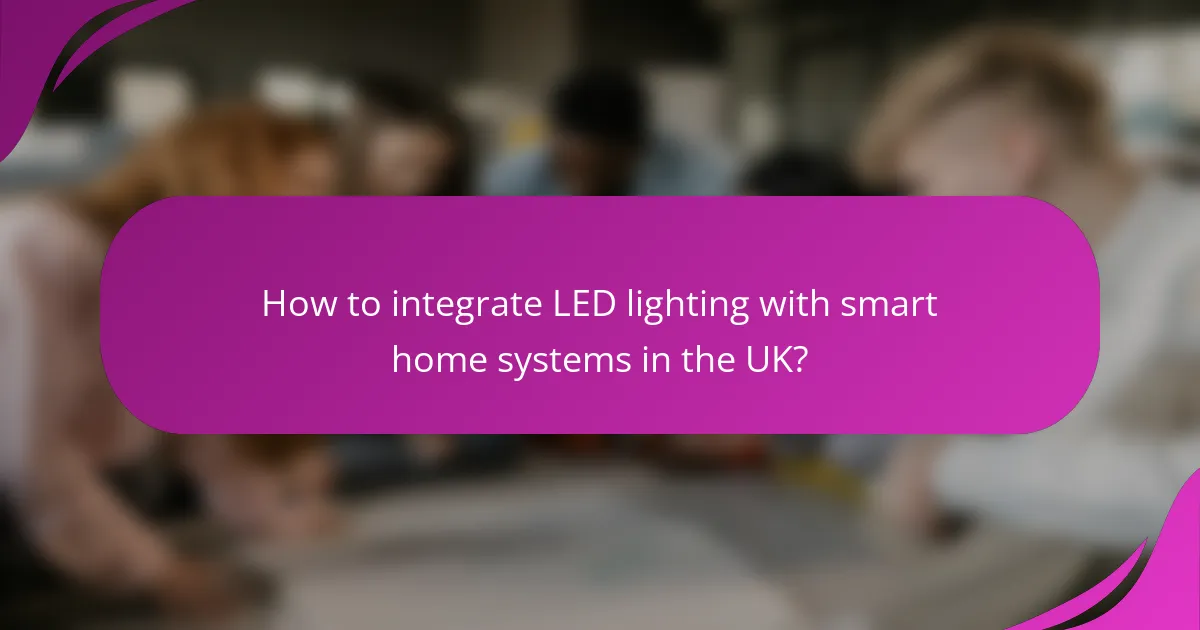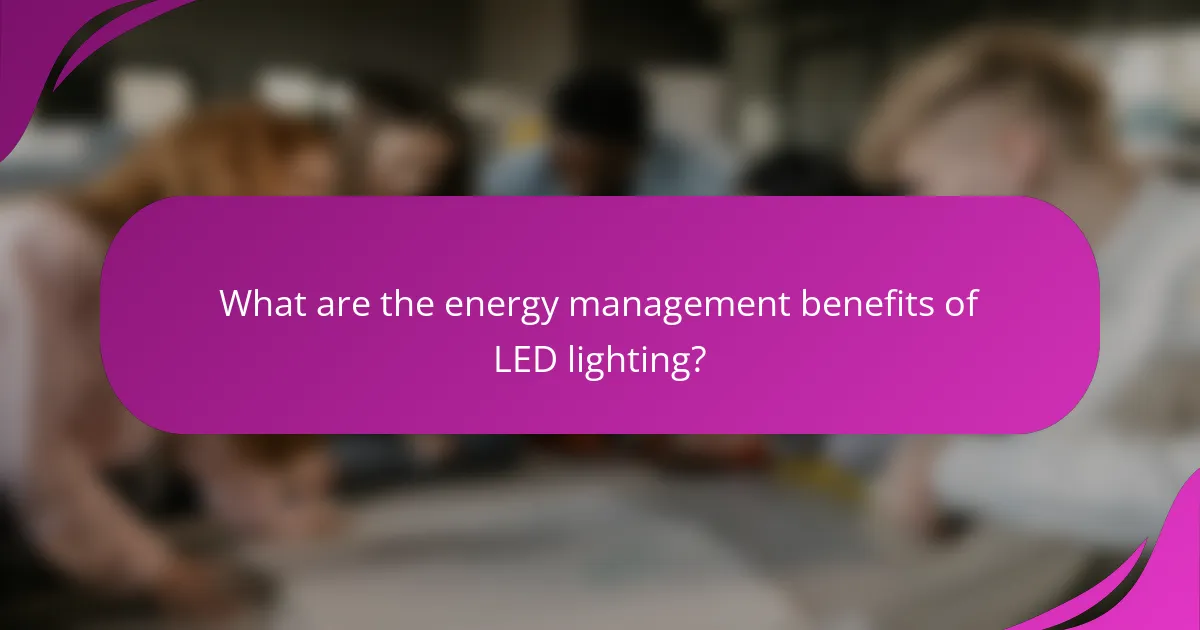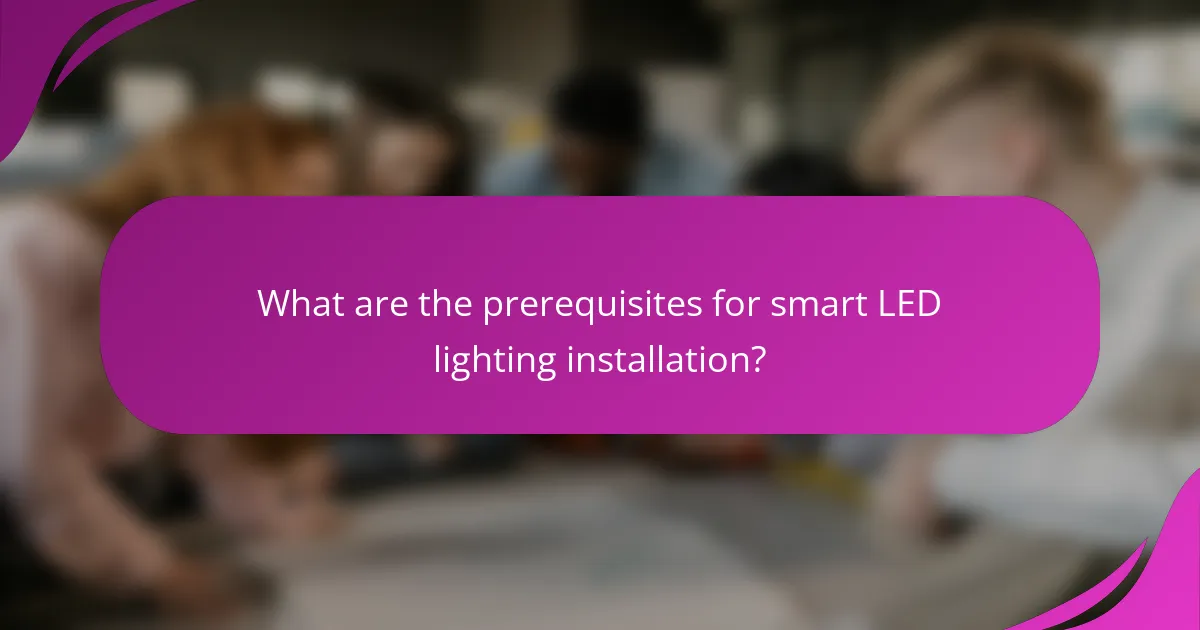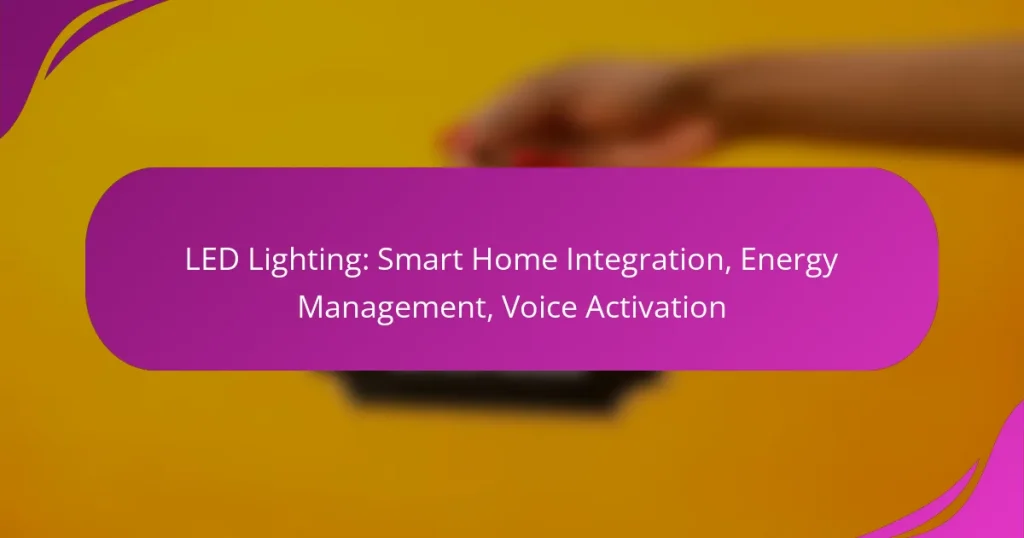LED lighting is revolutionizing smart home integration by offering energy-efficient solutions that enhance convenience and sustainability. With the right setup, homeowners can easily manage their lighting through smart hubs and voice activation, leading to reduced energy consumption and lower bills. This seamless integration not only simplifies daily routines but also contributes to a more eco-friendly lifestyle.

How to integrate LED lighting with smart home systems in the UK?
Integrating LED lighting with smart home systems in the UK involves selecting compatible products and setting them up through various platforms. Key considerations include ensuring your LED lights support smart technology and choosing a smart home hub that can control them effectively.
Compatibility with Amazon Alexa
Many LED lighting brands are compatible with Amazon Alexa, allowing you to control your lights using voice commands. To integrate, simply enable the corresponding skill in the Alexa app and link your LED lighting account.
Common brands like Philips Hue and LIFX offer seamless integration. Ensure your smart lights are connected to the same Wi-Fi network as your Alexa device for optimal performance.
Integration with Google Home
Google Home also supports a variety of LED lighting systems, enabling voice control and automation. To set up, add your smart lights through the Google Home app and follow the prompts to link your accounts.
Brands such as TP-Link and Wyze provide easy integration. Make sure your Google Home device and smart lights are on the same network to avoid connectivity issues.
Using Philips Hue for smart control
Philips Hue is a popular choice for smart LED lighting, offering a wide range of bulbs and fixtures. To use Philips Hue, install the Hue Bridge, which connects your lights to the app and allows for remote control.
The app lets you customize settings, create schedules, and set up routines. Philips Hue also works with both Amazon Alexa and Google Home for voice activation, enhancing your smart home experience.
Setting up with Apple HomeKit
Apple HomeKit provides a secure way to manage your LED lighting through the Home app on iOS devices. To set up, ensure your smart lights are HomeKit-compatible and follow the instructions to add them to your Home app.
Once integrated, you can control your lights using Siri voice commands or set up automation based on your location or time of day. Brands like Eve and LIFX support HomeKit, providing a range of options for users.

What are the energy management benefits of LED lighting?
LED lighting offers significant energy management benefits, including reduced energy consumption, lower electricity bills, and a longer lifespan compared to traditional bulbs. These advantages contribute to both cost savings and environmental sustainability.
Reduced electricity bills
Switching to LED lighting can lead to substantial savings on electricity bills. LEDs use up to 80% less energy than incandescent bulbs, which translates to lower monthly costs. For instance, replacing a standard 60-watt bulb with an 8- to 10-watt LED can save approximately $50 to $100 over the bulb’s lifetime, depending on local electricity rates.
To maximize savings, consider using LED bulbs in high-use areas such as living rooms and kitchens. Additionally, integrating smart home technology can further optimize energy use by allowing you to control lighting remotely and set schedules.
Longer lifespan compared to traditional bulbs
LED bulbs have a significantly longer lifespan than traditional incandescent or fluorescent bulbs, often lasting 15,000 to 50,000 hours. This longevity means fewer replacements and less waste, which is beneficial for both your wallet and the environment.
When selecting LED bulbs, look for those with a high lumen output and a good warranty, as these are indicators of quality. Investing in higher-quality LEDs can reduce the frequency of replacements and enhance overall energy management.
Lower carbon footprint
Using LED lighting contributes to a lower carbon footprint due to reduced energy consumption and longer lifespans. Since LEDs consume less power, they decrease the demand on power plants, which often rely on fossil fuels, thereby reducing greenhouse gas emissions.
To further minimize your carbon footprint, consider pairing LED lighting with renewable energy sources, such as solar panels. This combination not only enhances energy efficiency but also promotes sustainable living practices.

How to activate LED lights using voice commands?
Activating LED lights with voice commands is straightforward and enhances the convenience of smart home systems. By integrating your LED lighting with compatible voice assistants, you can control your lights hands-free using simple phrases.
Voice activation with Google Assistant
To activate LED lights using Google Assistant, ensure your smart lights are compatible and connected to the Google Home app. Once set up, you can use commands like “Hey Google, turn on the living room lights” or “Hey Google, dim the bedroom lights to 50%.” This allows for easy control of lighting based on your needs.
Consider creating routines in the Google Home app for more complex commands, such as turning on multiple lights at once or adjusting brightness levels throughout the day. This can streamline your daily activities and enhance energy management.
Using Siri for voice control
For Apple users, Siri can control LED lights through the HomeKit framework. Ensure your lights are HomeKit-compatible and added to the Home app. You can activate lights by saying, “Hey Siri, turn off the kitchen lights” or “Hey Siri, set the hallway lights to blue.”
Utilizing Siri also allows for automation, such as scheduling lights to turn on or off at specific times. This can help in managing energy consumption effectively and creating a welcoming atmosphere when you arrive home.
Setting up voice commands with Amazon Echo
To use voice commands with Amazon Echo, first connect your LED lights to the Alexa app. Once linked, you can issue commands like “Alexa, turn on the porch lights” or “Alexa, brighten the office lights.” This integration provides a seamless way to manage your lighting.
Additionally, consider creating groups in the Alexa app for controlling multiple lights simultaneously. For example, you can group all living room lights and say, “Alexa, turn off the living room,” which is efficient for energy management and convenience.

What are the best LED lighting brands for smart integration?
The best LED lighting brands for smart integration include Philips Hue, LIFX, and TP-Link Kasa Smart. These brands offer a variety of smart bulbs and fixtures that seamlessly connect with home automation systems, providing convenience and energy efficiency.
Philips Hue
Philips Hue is a leading brand known for its extensive range of smart LED lighting solutions. Their products easily integrate with popular smart home systems like Amazon Alexa, Google Assistant, and Apple HomeKit, allowing for voice control and automation.
When considering Philips Hue, note that their bulbs typically require a Hue Bridge for full functionality, which enables remote access and advanced features. The brand offers various options, including color-changing bulbs, outdoor lights, and light strips, catering to diverse lighting needs.
LIFX
LIFX stands out for its vibrant color options and Wi-Fi connectivity, eliminating the need for a hub. This makes setup straightforward, as users can control their lights directly through the LIFX app or compatible voice assistants.
One key advantage of LIFX is its high brightness and rich color spectrum, making it ideal for creating dynamic lighting scenes. However, users should consider that LIFX bulbs may consume slightly more energy than some competitors, so energy management is essential.
TP-Link Kasa Smart
TP-Link Kasa Smart offers a solid range of affordable smart LED bulbs that integrate well with various smart home ecosystems. Their products are user-friendly, featuring easy installation and a straightforward app for control.
While Kasa Smart bulbs may not have as many advanced features as Philips Hue or LIFX, they provide reliable performance and good energy efficiency. Users should be aware that some models might require a Kasa Smart Hub for certain functionalities, so checking compatibility is advisable before purchase.

What are the prerequisites for smart LED lighting installation?
To successfully install smart LED lighting, you need a reliable Wi-Fi network and compatibility with a smart home hub. These elements ensure seamless communication between your lighting system and other smart devices.
Wi-Fi network requirements
A strong and stable Wi-Fi network is essential for smart LED lighting to function effectively. Most smart LED bulbs require a 2.4 GHz Wi-Fi connection, though some may also support 5 GHz networks. Ensure your router is positioned to minimize dead zones in your home.
Consider the number of devices connected to your network, as a crowded network can lead to slow response times. A dedicated Wi-Fi network for smart devices can enhance performance and reliability.
Smart home hub compatibility
Smart LED lights often require integration with a smart home hub for optimal functionality. Check if your chosen lighting system is compatible with popular hubs like Amazon Echo, Google Nest, or Apple HomeKit. This compatibility allows for centralized control and automation.
When selecting a hub, consider its features, such as voice control and compatibility with other smart devices. Ensure that the hub can support the number of smart LED lights you plan to install, as some hubs have limitations on the number of connected devices.

How to choose the right LED lighting for energy efficiency?
To choose the right LED lighting for energy efficiency, focus on lumens per watt, color temperature, and the intended use of the space. Selecting bulbs with higher lumens per watt ensures you get more light output for less energy consumption, while the right color temperature can enhance the ambiance of your home.
Understanding lumens and watts
Lumens measure the brightness of a light bulb, while watts indicate the energy consumption. When selecting LED lighting, aim for bulbs that provide a high lumen output with low wattage to maximize energy efficiency.
For instance, a typical LED bulb may produce around 800 lumens while consuming only 10-12 watts, compared to an incandescent bulb that uses about 60 watts for the same brightness. This significant reduction in wattage translates to lower energy bills and a reduced carbon footprint.
When evaluating options, consider the space’s lighting needs. For general lighting, look for bulbs that offer around 80-100 lumens per square meter. For task lighting, such as reading or cooking, you may need higher lumens to ensure adequate visibility.


